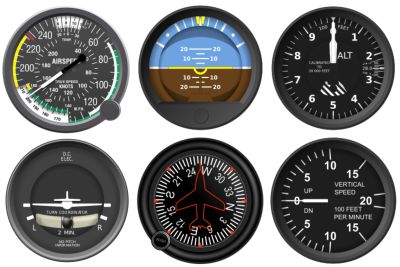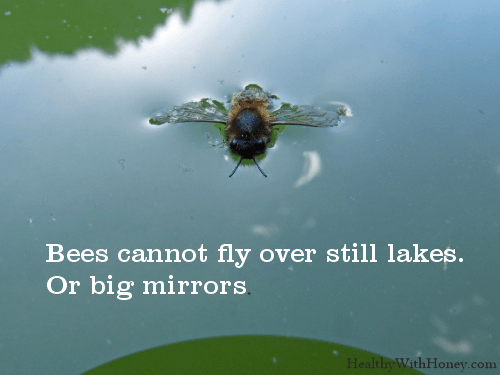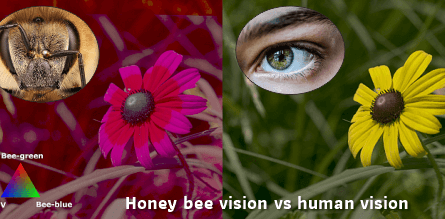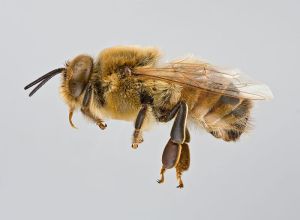Did you know that bees cannot fly over a mirror or a still lake?
It’s true, they can’t. They crash into the ground because they cannot gauge their altitude.
Sometimes, the same thing happens to human pilots. It is a biological fact called spatial disorientation. When pilots are unable to see their ground speed, they struggle to maintain their altitude.
But don’t worry about that, in our help, we have the airplane instruments that measure the altitude. These instruments help us overcome spatial illusions and keep our aircraft aloft even when there is no texture or shadow on the ground or water below.

Standard set of flight instruments, including attitude indicator (top center)
and turn and slip indicator (bottom left). Picture source Wikimedia commons.
Humans are worse than bees at spatial disorientation. We are even told to not look down, for fear we will fall. A bees has to always look down in searching for food.
Two experiments prove that bees cannot fly over a still lake
• In January 1963, two scientists, Herbert Heran, an Austrian entomologist, and Martin Lindauer, a German behavioral scientist, noticed the strange behavior of honey bees when flying over a lake.
They trained the bees to a feeding station with sucrose solution. The course of flight led across water and covered a distance of 247 m.
Here is what they observed: “When the water surface was mirror smooth, a great number of bees plunged into the water. They continually lost altitude until they crashed headlong into the water, witch thereby flipped them onto their backs.” This phenomenon did not repeat when the water was rippled or, during smooth water, when the course was marked with a bridge of floating boards.
At that time, the findings supported the idea that honeybees would use visual cues to navigate during flight.
More recently, the 1963 experiment was replicated.
• In this experiment, researchers used a 220-centimeter-long (87 inches) rectangular tunnel placed outdoors, with mirrors on the ceiling and the floor that could be covered to look like plain old walls.
– when all the mirrors were covered, the honeybees could flee from one side of the tunnel to a sweet treat on the other side while maintaining a near-constant altitude;
– when the ceiling was pulled back to reveal a mirror, seemingly doubling the height of the tunnel, the bees easily made it across; (no problem with the sky, then!)
– when the floor became a mirror, making the ground look doubly far away, the crashes began. The bees would start out flying normally, but after about 40 centimeters (15 inches) of flight, their altitude would begin to drop until the insects collided with the glass bottom;
– when both the ceiling and the floor were mirrors, creating a parallel pair of infinite walls, the bees would start losing altitude after only 8 cm (3 inches), then crash.
The explanation is that bees use visual cues on the ground to maintain their altitude, as opposed to visual cues from above them in the sky. But when the ground is no longer giving the insects a proper baseline, they drop lower in altitude to regain that “ventral optic flow”.
The same thing happens to humans.
You may have heard of graveyard spiral, or suicide spiral, deadly spiral, death spiral or vicious spiral. This happens when the pilot experiences spatial disorientation and loses awareness of the aircraft’s attitude. Graveyard spirals are most common at night or in poor weather conditions where no horizon exists to provide visual correction for misleading inner-ear cues.
But this doesn’t happen to all insects.
Fruit flies do not use ventral optic flow to control their altitude. Using a 3D virtual reality environment, we found that Drosophila utilize three reflexes—edge tracking, wide-field stabilization, and expansion avoidance—to control altitude (study by Andew D. Straw at all, Visual Control of Altitude in Flying Drosophila, 2010).
References:
· Heran, H., Lindauer, M. Windkompensation und Seitenwindkorrektur der Bienen beim Flug über Wasser. Zeitschrift für vergleichende Physiologie 47, 39–55 (1963). https://doi.org/10.1007/BF00342890
https://en.wikipedia.org/wiki/Graveyard_spiral
Featured image credit: Makamuki0 via pixabay.com




